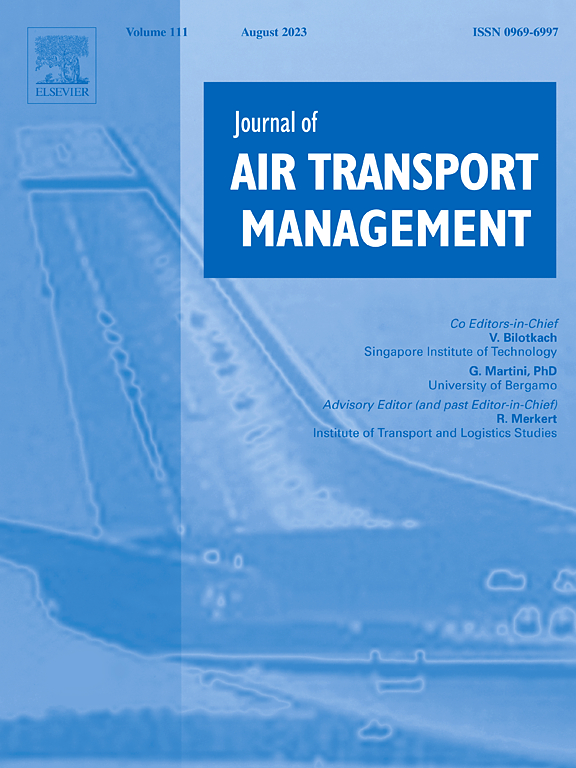Study on the subsidy efficiency of small and medium-sized airports in China based on social economic impact
IF 3.6
2区 工程技术
Q2 TRANSPORTATION
引用次数: 0
Abstract
Existing studies on airport efficiency predominantly emphasize operational performance, often overlooking airports' social responsibilities as public infrastructure. This study adopts a socioeconomic impact analysis perspective to evaluate the subsidy efficiency of 56 small and medium-sized airports in China from 2015 to 2019, offering insights to improve the interaction between airport operations and socioeconomic development. The study consists of two main components. Firstly, Network Data Envelopment Analysis (NDEA) decomposes the subsidy process into two sub-processes: stimulating air transport volume and enhancing socioeconomic development, enabling a detailed efficiency assessment. Secondly, a panel data regression model is utilized to analyze the key factors influencing subsidy efficiency. The efficiency assessment highlights that the weak correlation between airport operations and regional economic development is the primary barrier to improving subsidy efficiency. Additionally, the results reveal significant geographic disparities, with airports in eastern regions exhibiting higher subsidy efficiency than those in the west. The panel regression analysis identifies several factors with substantial positive effects on subsidy efficiency, including the number of airlines and connected destinations, the city's population size, and highway passenger traffic. To the best of our knowledge, this study is among the first to evaluate airport subsidy efficiency, specifically focusing on social economic outcomes, particularly for small and medium-sized airports. By extending the scope of existing research on airport efficiency evaluation, this study contributes to a deeper understanding of the role of subsidies in supporting smaller airports and their relationship with social development.
基于社会经济影响的中国中小机场补贴效率研究
现有的机场效率研究主要强调运营绩效,往往忽视了机场作为公共基础设施的社会责任。本研究采用社会经济影响分析的视角,对2015 - 2019年中国56个中小机场的补贴效率进行评估,为改善机场运营与社会经济发展的互动提供参考。这项研究主要由两个部分组成。首先,网络数据包络分析(NDEA)将补贴过程分解为刺激航空运输量和促进社会经济发展两个子过程,从而进行详细的效率评估。其次,利用面板数据回归模型分析影响补贴效率的关键因素。效率评价结果表明,机场运营与区域经济发展关联度较弱是影响补贴效率提高的主要障碍。此外,研究结果还显示出显著的地域差异,东部地区的机场补贴效率高于西部地区。面板回归分析确定了几个对补贴效率有实质性积极影响的因素,包括航空公司和连接目的地的数量,城市人口规模和高速公路客运量。据我们所知,这项研究是第一批评估机场补贴效率的研究之一,特别关注社会经济成果,特别是对中小型机场。通过扩展现有机场效率评价研究的范围,本研究有助于更深入地了解补贴在支持小型机场方面的作用及其与社会发展的关系。
本文章由计算机程序翻译,如有差异,请以英文原文为准。
求助全文
约1分钟内获得全文
求助全文
来源期刊

Journal of Air Transport Management
TRANSPORTATION-
CiteScore
12.40
自引率
11.70%
发文量
97
期刊介绍:
The Journal of Air Transport Management (JATM) sets out to address, through high quality research articles and authoritative commentary, the major economic, management and policy issues facing the air transport industry today. It offers practitioners and academics an international and dynamic forum for analysis and discussion of these issues, linking research and practice and stimulating interaction between the two. The refereed papers in the journal cover all the major sectors of the industry (airlines, airports, air traffic management) as well as related areas such as tourism management and logistics. Papers are blind reviewed, normally by two referees, chosen for their specialist knowledge. The journal provides independent, original and rigorous analysis in the areas of: • Policy, regulation and law • Strategy • Operations • Marketing • Economics and finance • Sustainability
 求助内容:
求助内容: 应助结果提醒方式:
应助结果提醒方式:


